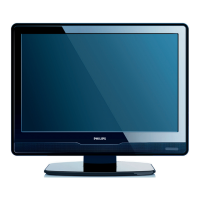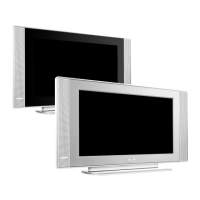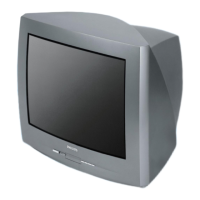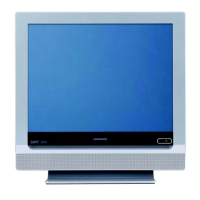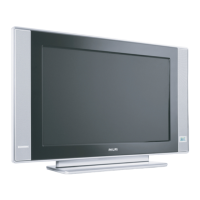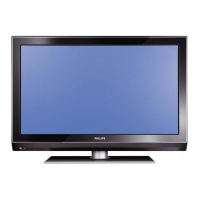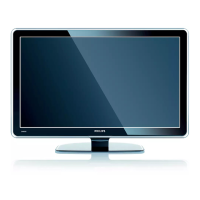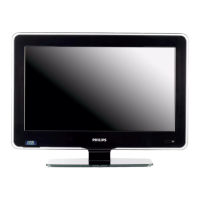Do you have a question about the Philips 26PFL3403/10 and is the answer not in the manual?
Crucial safety guidelines for handling and operating the TV to prevent injury or damage.
Instructions for cleaning the TV screen safely and effectively to prevent damage.
Information on product disposal and recycling for environmental responsibility.
An introduction to the TV's physical layout, including side controls and indicators.
Details and identification of all input and output ports on the rear of the TV.
Explanation of the buttons and functions of the TV's remote control for operation.
Guidance on optimal TV placement and secure wall mounting procedures.
Steps for connecting cables, inserting batteries, and initial TV power-up.
How to turn the TV on, switch to standby, and turn it off.
Information on product warranty, user-serviceable parts, and conditions that void the warranty.
Explanation of pixel properties and acceptable display variations like dead pixels.
Details on EMF compliance, UK mains fuse replacement, and copyrights.
Ensuring adequate space around the TV for ventilation and proper placement.
Warnings about liquid contact, short circuits, and handling power cords.
Emphasizes professional installation for wall mounting to prevent injury or damage.
Proper procedures for unplugging the TV from the mains socket and power connector.
Advice on limiting earphone volume to prevent permanent hearing loss.
Instructions for cleaning the TV screen with a soft, dry cloth, avoiding chemicals.
Information on recycling packaging, proper product disposal, and used batteries.
Identification and function of the physical controls and status indicators on the TV's side.
Connecting computers and high-definition devices via VGA and HDMI ports.
Guide to the initial TV setup process, including country and language selection.
Instructions for swapping, renaming, deleting, and managing favorite TV programs.
Procedure for automatically scanning and storing active TV channels.
Steps for manually installing programs by selecting reception, frequency, and naming.
Methods for changing channels and selecting audio-visual input sources.
Controlling TV sound volume and viewing status information on screen.
How to view the complete list of available TV programs and AV connections.
Accessing and adjusting sound settings like tone, balance, and preset sound modes.
Adjusting picture settings like brightness, color, contrast, and advanced options.
Setting the TV's clock and programming automatic turn-off or wake-up timers.
Setting a PIN code to restrict program access and control TV features.
Locking specific programs, front panel buttons, and menu access using the PIN.
Configuring TV preferences like language, volume limits, and AV socket names.
How to access, navigate, and use Teletext pages and subpages.
Details on newsflashes, subtitles, alarm pages, and different Teletext modes.
List of supported display resolutions and video formats with refresh rates.
Details of all input/output connections and power specifications.
Solutions for common issues like no picture, no sound, or color problems.
Troubleshooting remote control issues and resolving picture interference.
Resolving problems with picture quality such as ripples, snow, ghosting, or blank screens.
Crucial safety guidelines for handling and operating the TV to prevent injury or damage.
Instructions for cleaning the TV screen safely and effectively to prevent damage.
Information on product disposal and recycling for environmental responsibility.
An introduction to the TV's physical layout, including side controls and indicators.
Details and identification of all input and output ports on the rear of the TV.
Explanation of the buttons and functions of the TV's remote control for operation.
Guidance on optimal TV placement and secure wall mounting procedures.
Steps for connecting cables, inserting batteries, and initial TV power-up.
How to turn the TV on, switch to standby, and turn it off.
Information on product warranty, user-serviceable parts, and conditions that void the warranty.
Explanation of pixel properties and acceptable display variations like dead pixels.
Details on EMF compliance, UK mains fuse replacement, and copyrights.
Ensuring adequate space around the TV for ventilation and proper placement.
Warnings about liquid contact, short circuits, and handling power cords.
Emphasizes professional installation for wall mounting to prevent injury or damage.
Proper procedures for unplugging the TV from the mains socket and power connector.
Advice on limiting earphone volume to prevent permanent hearing loss.
Instructions for cleaning the TV screen with a soft, dry cloth, avoiding chemicals.
Information on recycling packaging, proper product disposal, and used batteries.
Identification and function of the physical controls and status indicators on the TV's side.
Connecting computers and high-definition devices via VGA and HDMI ports.
Guide to the initial TV setup process, including country and language selection.
Instructions for swapping, renaming, deleting, and managing favorite TV programs.
Procedure for automatically scanning and storing active TV channels.
Steps for manually installing programs by selecting reception, frequency, and naming.
Methods for changing channels and selecting audio-visual input sources.
Controlling TV sound volume and viewing status information on screen.
How to view the complete list of available TV programs and AV connections.
Accessing and adjusting sound settings like tone, balance, and preset sound modes.
Adjusting picture settings like brightness, color, contrast, and advanced options.
Setting the TV's clock and programming automatic turn-off or wake-up timers.
Setting a PIN code to restrict program access and control TV features.
Locking specific programs, front panel buttons, and menu access using the PIN.
Configuring TV preferences like language, volume limits, and AV socket names.
How to access, navigate, and use Teletext pages and subpages.
Details on newsflashes, subtitles, alarm pages, and different Teletext modes.
List of supported display resolutions and video formats with refresh rates.
Details of all input/output connections and power specifications.
Solutions for common issues like no picture, no sound, or color problems.
Troubleshooting remote control issues and resolving picture interference.
Resolving problems with picture quality such as ripples, snow, ghosting, or blank screens.
| Screen Size | 26 inches |
|---|---|
| Resolution | 1366 x 768 pixels |
| Display Type | LCD |
| HD type | HD Ready |
| Aspect Ratio | 16:9 |
| Refresh Rate | 50 Hz |
| USB Ports | 1 |
| Weight | 8.5 kg |
| Response time | 8 ms |
| Dynamic contrast ratio marketing name | Dynamic Contrast |
| Comb filter | 3D |
| Audio system | Nicam Stereo |
| Number of speakers | 2 |
| Component video (YPbPr/YCbCr) in | 1 |
| SCART ports quantity | 1 |
| S-Video inputs quantity | 1 |
| PC in (D-Sub) | 1 |
| Common interface (CI) | Yes |
| Digital audio coaxial out | 1 |
| Headphone outputs | 1 |
| Teletext function | Yes |
| Teletext | 1000 pages |
| Power consumption (typical) | 75 W |
| Power consumption (standby) | 0.15 W |
| Screen format adjustments | Zoom |
| Viewing angle, horizontal | 176 degrees |
| Viewing angle, vertical | 176 degrees |
| Width (with stand) | 66.5 cm |
| Width (without stand) | 66.5 cm |
